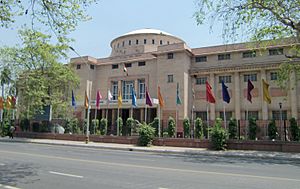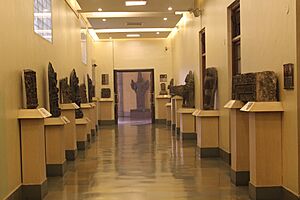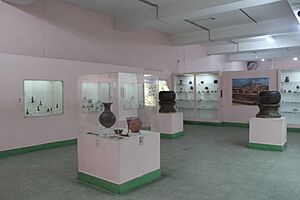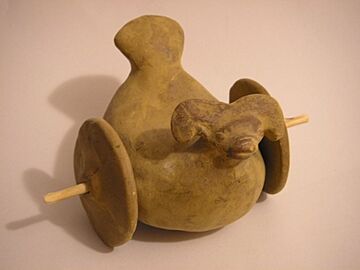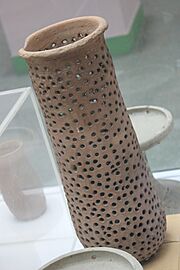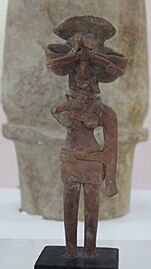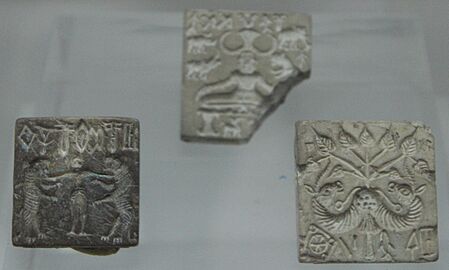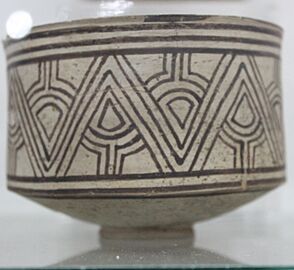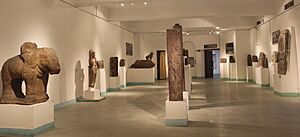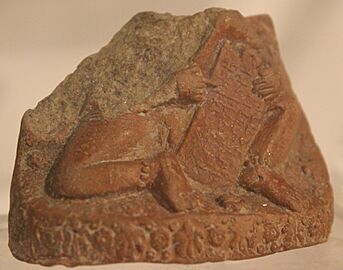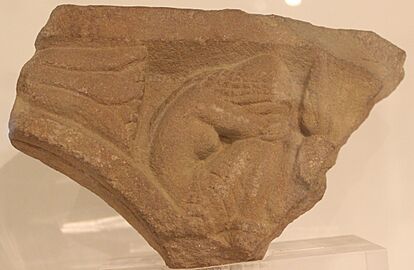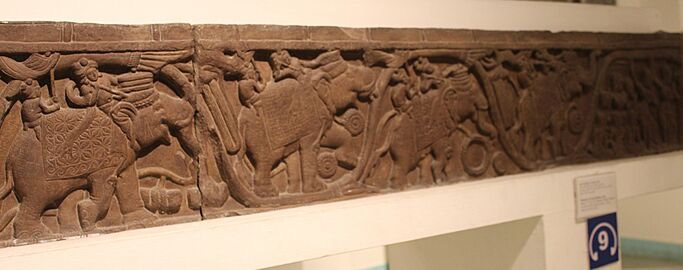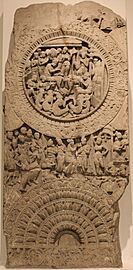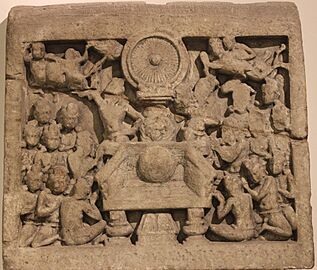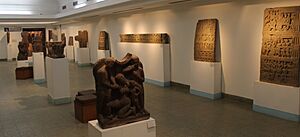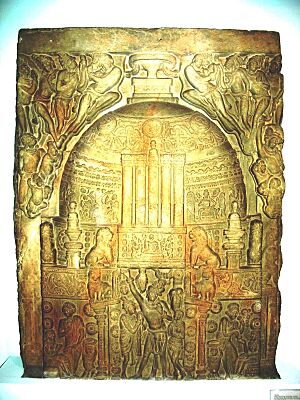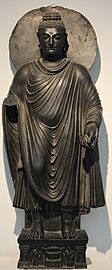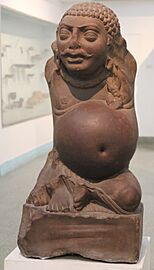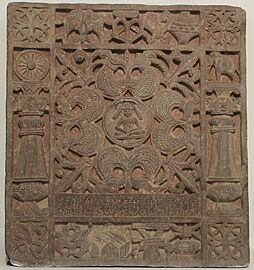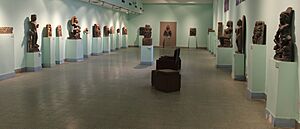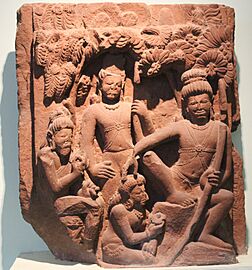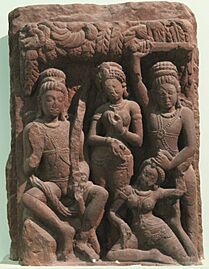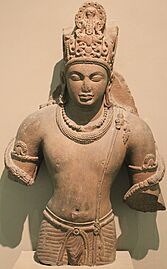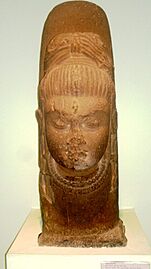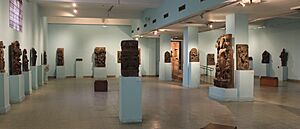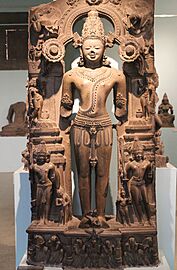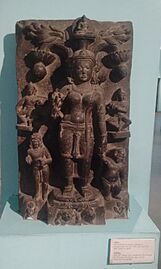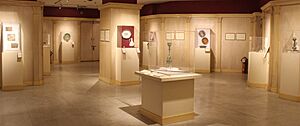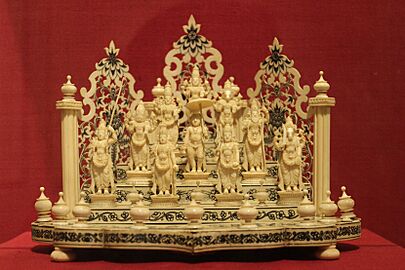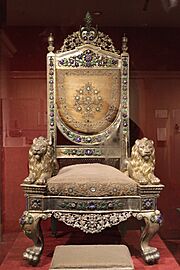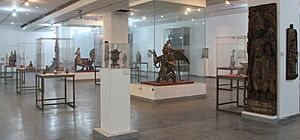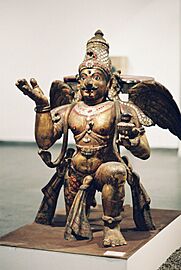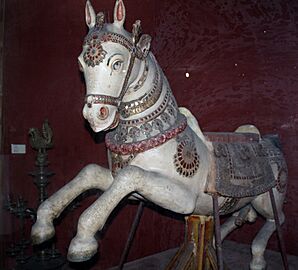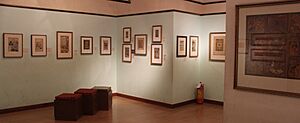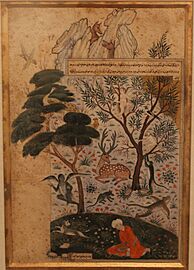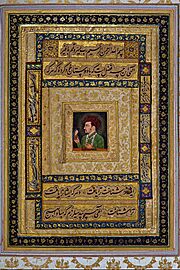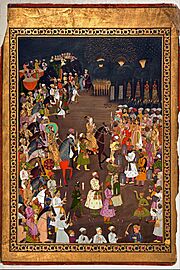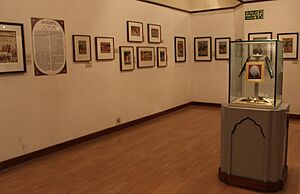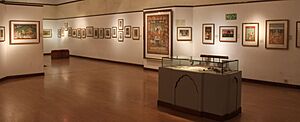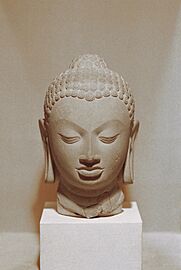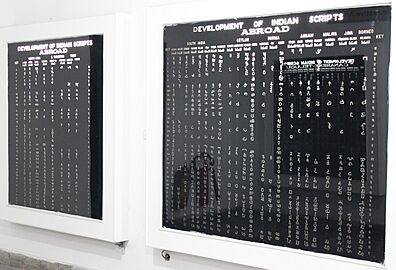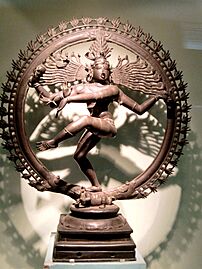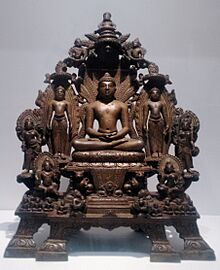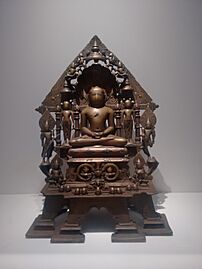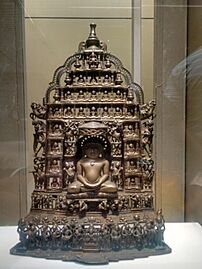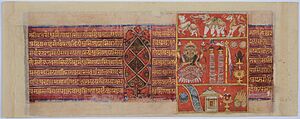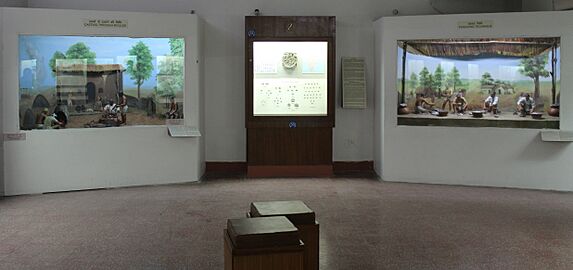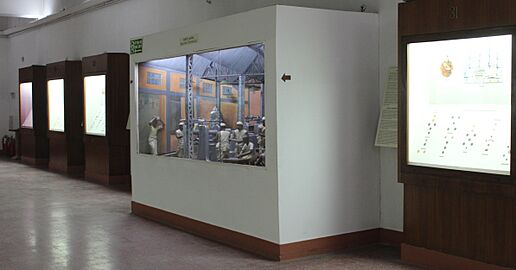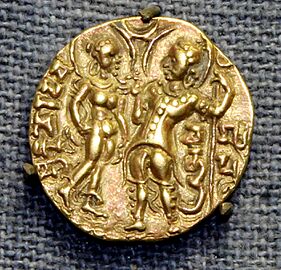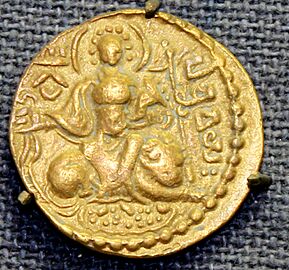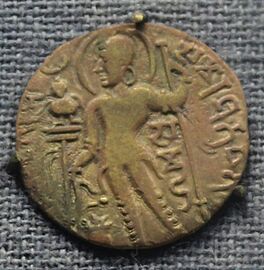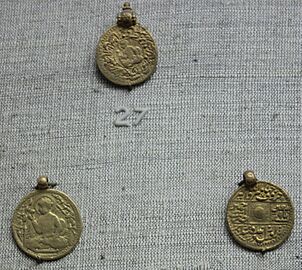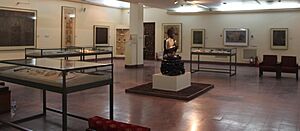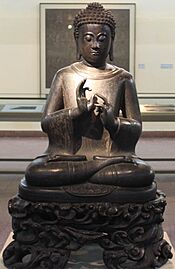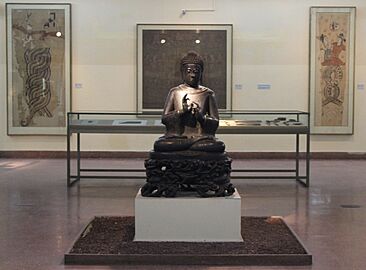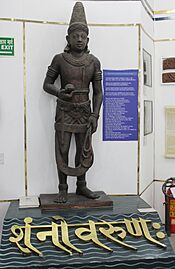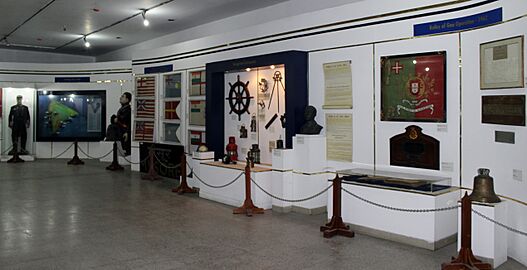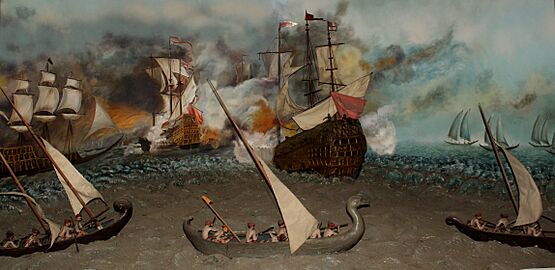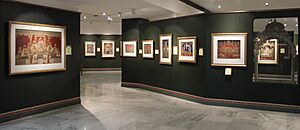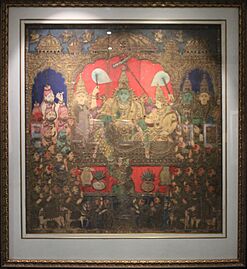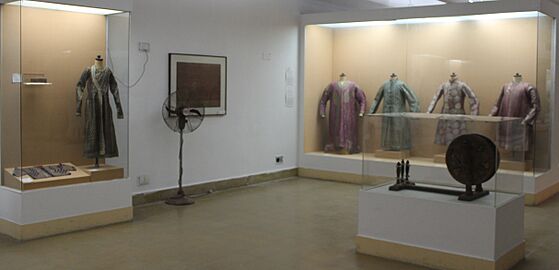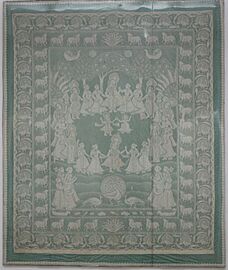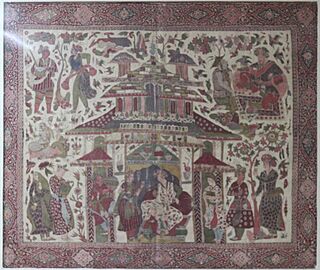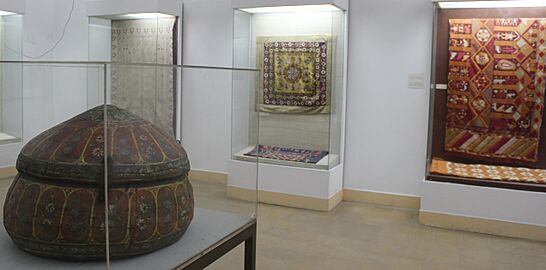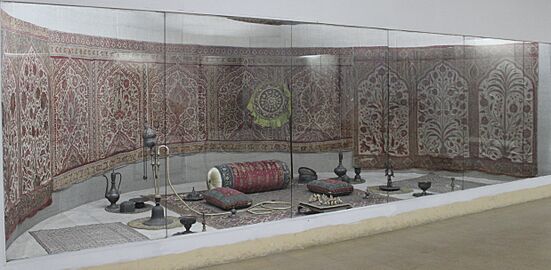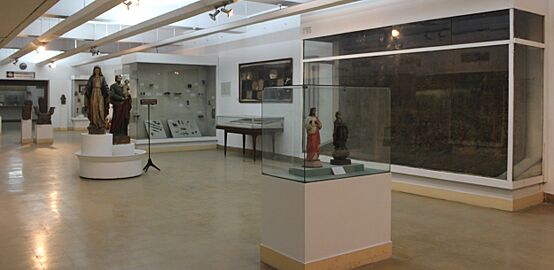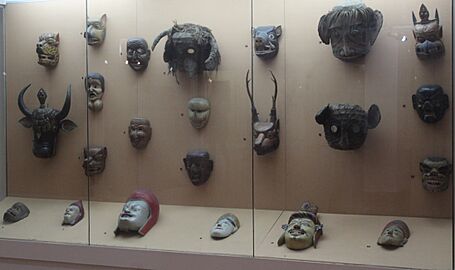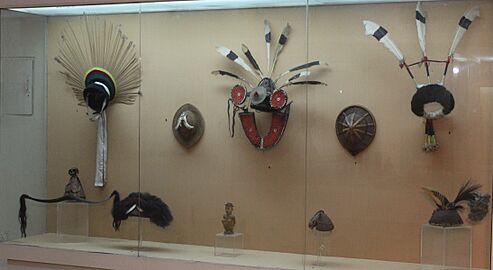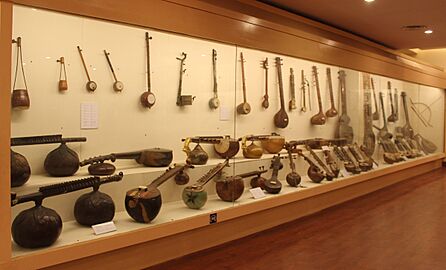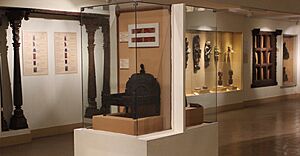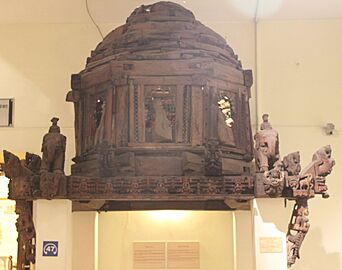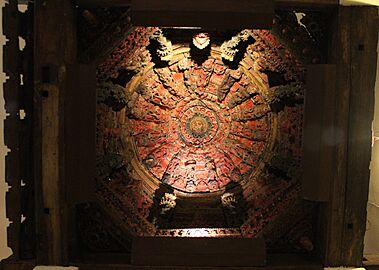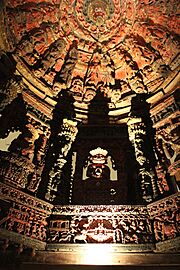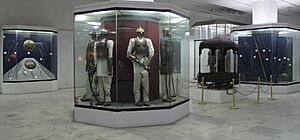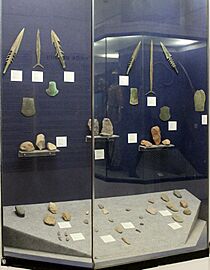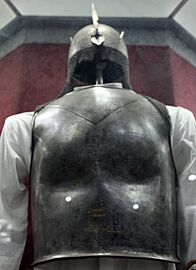National Museum of India facts for kids
The National Museum in New Delhi, also known as the National Museum of India, is one of the biggest museums in India. It opened in 1949 and has many different items. These items range from very old pre-historic times to modern art. The museum is run by the Ministry of Culture of the Government of India. You can find it on Janpath in New Delhi. The museum has about 200,000 pieces of art. Most are from India, but some are from other countries. They cover more than 5,000 years of history!
The museum also has a special school on its first floor. This school, called the National Museum Institute, teaches about art history, how to take care of old items (conservation), and how museums work (museology). It became a university in 1989.
Contents
- History of the National Museum
- Museum Collections and Departments
- The Museum Building
- Museum Collections
- Harappan Civilization Gallery
- Maurya, Shunga and Satvahana Arts Gallery
- Kushana Gallery
- Gupta Gallery
- Medieval Arts Gallery
- Decorative Arts Gallery
- Miniature Paintings Gallery
- Buddhist Artifacts Gallery
- Evolution of Indian Scripts and Coins Gallery
- Bronze Gallery
- Manuscripts Gallery
- Coins Gallery
- Central Asian Gallery
- Maritime Heritage Gallery
- Tanjore and Mysore Paintings Gallery
- Textiles Gallery
- Pre-Columbian and Western Arts Gallery
- Anthropology Department
- Wood Carving Gallery
- Arms and Armour Gallery
- Tradition, Art, and Continuity
- Anubhav: A Tactile Experience
- Museum Management
- Digitizing Museum Collections
- Exhibition: The Indo-Siam Connect
- See also
History of the National Museum
The idea for a National Museum in India started in 1946. A group called the Gwyer Committee suggested it. Sir Maurice Gwyer, a former chief justice, led this group.
The museum's beginnings are linked to an exhibition of Indian art in London. This show happened in 1947–48. It was one of the first times Indian art was shown as important art by the British government. After the exhibition, Jawaharlal Nehru wanted these important items to be shown in India. This way, people in India could enjoy them. Many museums and collectors gave their items to help start the National Museum.
The first display of these items was on August 15, 1949. They were shown in the Rashtrapati Bhavan, which was then called Government House. C. Rajagopalachari, who was the Governor General of India, officially opened these rooms. The museum stayed in these rooms until the mid-1950s.
Building for the new, current museum started in 1955 on Janpath. The new building was ready in 1960. However, some famous statues, like the Buddha and the Rampurva Bull, stayed at the Rashtrapati Bhavan.
Grace Morley was the first director of the National Museum. She started on August 8, 1960, and worked there for six years. She believed that art should be for everyone. She wanted museums to help people see and appreciate art. She designed the museum's displays to be simple and clear. This helped the museum become known around the world.
Museum Collections and Departments
The National Museum has many different departments. Each department focuses on a special type of art or history.
- Pre-History Archaeology (very old items)
- Archaeology (ancient discoveries)
- Manuscripts (old handwritten books)
- Numismatics & Epigraphy (coins and inscriptions)
- Paintings (artworks)
- Arms & Armour (weapons and protective gear)
- Decorative Arts (beautiful everyday objects)
- Central Asian Antiquities (items from Central Asia)
- Pre-Columbian Art (art from before Columbus in America)
- Jewellery (ornaments)
- Anthropology (human cultures)
- Education (learning programs)
- Public Relations (connecting with visitors)
- Publication (making books and guides)
- Conservation (taking care of items)
- Display (how items are shown)
The museum's collections cover almost all types of art. These include archaeology (like stone and bronze statues), weapons, armour, decorative arts, jewellery, manuscripts, miniature and Tanjore paintings, textiles, numismatics (coins), epigraphy (inscriptions), and items from Central Asia. It also has collections on anthropology and art from Pre-Columbian America and the Western world.
The museum has over 200,000 art pieces. But it can only show about 6-7% of them at one time. The other items are shown in turns or in special temporary exhibitions.
The Museum Building
The National Museum building was designed by Ganesh Bhikaji Deolalikar. The first Prime Minister of India, Jawaharlal Nehru, laid its foundation stone on May 12, 1955. The new museum building was opened by Sarvepalli Radhakrishnan, who was the Vice-President of India, on December 18, 1960. The building stands where Edwin Lutyens had planned for an Imperial Museum. This spot was once home to a small museum with items collected by the explorer Aurel Stein.
The National Museum building was planned to be built in stages to eventually have an octagonal (eight-sided) shape. The first part opened in 1960, and the second part was finished in 1989. A third and final stage was planned to complete the building. The National Museum building has three floors. Galleries spread out from a central garden area.
Museum Collections
Harappan Civilization Gallery
This gallery shows many items from the Harappan civilization, also known as the Indus Valley civilization. It has one of the best collections of Harappan items in the world. There are over 3,500 objects here. These items are on long-term loan from the Archaeological Survey of India.
One of the most famous items is the Dancing Girl statue made of bronze. It is from the early Harappan period. You can also see a skeleton found at Rakhigarhi in Haryana, clay statues of the Mother Goddess, and pottery. The gallery also has sculptures, bone and ivory objects, jewelry, and painted pottery. Many seals are also on display. These seals were found during digs and were likely used for trading. They show animals like bulls, elephants, and tigers, and also unknown symbols. One seal shows a figure called Pasupati, which some think is an early form of the god Shiva.
When the ancient city of Mohenjo-daro was dug up in the 1920s, important finds were first kept in Lahore. Later, they were moved to Delhi for the new museum. When India was divided in 1947, India and Pakistan agreed to share all the collections equally. Sometimes, this meant taking necklaces apart and sending half the beads to Pakistan and half to India! Pakistan received the stone statue of the 'Priest King'. India kept the bronze 'Dancing Girl' statue. The gallery also has items found after 1947 in places like Daimabad and Dholavira.
Some key items in this collection are:
- Mother Goddess (2700–2100 BC)
- Toy Cart (2700–2100 BC)
- Bull (2700–2100 BC)
- Pasupati Seal (2700–2100 BC)
- Climbing Monkey (2700–2100 BC)
- Dancing Girl (2700–2100 BC)
-
Toy cart from Mohenjo-daro
Maurya, Shunga and Satvahana Arts Gallery
This gallery displays objects from the 4th to 1st centuries BCE. These items come from three important ancient Indian kingdoms: the Mauryas, the Shungas, and the Satvahanas. Many objects here show Greek influence, with a very smooth, mirror-like finish.
The gallery also has pieces of railings from old Stupas (Buddhist shrines). These railings are carved with stories from Buddha's life. One important piece shows Sage Asita visiting baby Siddharta. Another shows railings from Bharhut that tell a story about Buddha's relics. During this period, Buddha was not shown as a human figure in sculptures. Instead, symbols like the Dharmachakra (wheel of law), the Bodhi tree, an empty throne, or footprints were used to represent him.
-
Asita visiting King Suddhodana (Satvahana period)
Kushana Gallery
This gallery features art from the Kushan period (1st – 3rd century CE). Two main art styles were popular: the Gandhara School of Art and the Mathura School of Art. The Gandhara style was heavily influenced by Greek art and mostly showed Buddhist themes. A key item is the Standing Buddha, made of grey schist stone in the Gandhara style, from the 2nd century CE. This was the first time Buddha was shown in human form. The Mathura style focused on Buddhism, Jainism, and Brahmanism.
Other sculptures include Kuber (the Hindu god of wealth) from Ahichchhatra, the Chattramukhi Shivlinga, a Bodhisattva, and Jain votive plaques.
Gupta Gallery
This gallery shows items from the Gupta dynasty (4th–6th centuries CE). Art from the Gupta period is considered a high point in Indian art. Mathura and Sarnath were important art centers. With support from Gupta rulers, sculptures became very perfect in their shape. This set the standard for beauty for many centuries. During this time, important changes happened in how gods and figures were shown. Gupta sculptures are known for their well-proportioned figures and clear features.
- Sculptures showing scenes from the famous stories of Ramayana and Mahabharata:
-
Scenes from Mahabharata
- Other sculptures:
-
Mukhalinga of Shiva, 5th century CE
Medieval Arts Gallery
Sculptures from the medieval period are split into two groups: Early and Late. Each group has its own gallery.
Early Medieval Artefacts
This gallery has sculptures from the 7th to 10th centuries. After the Gupta empire ended, India was divided. Different kingdoms ruled different parts, like the Palas in the East and the Pallavas in the South. During this time, the quality of art generally went down. This was because there were fewer master artists, but many temples were being built.
Late Medieval Artefacts
This gallery shows sculptures from the 10th to 13th centuries. During this time, India was further divided into many smaller kingdoms.
Some main items in this gallery are:
- The Sun God statue.
- A beautiful statue of Saraswati, the goddess of music and learning. This marble statue from Rajasthan is very detailed.
-
Surya (From Sun Temple, Konarak)
-
Neminatha (22nd Jain Tirthankar), 11th century
Decorative Arts Gallery
The Decorative Arts collection shows how people in India lived from the 16th to the 20th century. Decorative Arts are objects that are useful but also beautifully designed. These include items made by skilled craftspeople. They help us understand how Indian society developed in terms of social life, religion, economy, trade, and technology. This section includes ceramics, Pottery, Furniture, Textiles, Glassware, metalware, and Jewellery. The Decorative Arts section is divided into two galleries.
Decorative Arts Gallery 1
This gallery shows three types of collections: Ivory, Jade, and Ceramics. The Ivory collection has many Hindu and Christian religious figures. The Jade section displays useful objects. The Ceramic group has glazed tiles and blue-white pottery.
The gallery also has two interesting themes: "Thrones of India" and "Games and Leisure in the Past." The "Thrones" theme shows how seats of power changed over time. From low, flat seats to modern chairs, the story of thrones is fascinating. There is also a beautifully carved Home Shrine and small metal seats for idols. The jewel-covered throne of the King of Varanasi is a great example of royal power.
The "Games" section has rattles, yo-yos, chess pieces, and tops made of different materials. These items show how everyday objects for games were also artistic. The Jade Collection has interesting items from the Mughal period.
Decorative Arts Gallery 2
This gallery has items from very old times (proto-historic) up to today. The types and quality of items changed as people's tastes and social status changed. This gallery shows Metalware, Jewellery, and Wooden objects. The Vahana (mounts for deities) on display are especially notable among the wooden objects.
-
Wooden Garuda Vahana (mount) from Tamil Nadu
Miniature Paintings Gallery
Miniature paintings are small, detailed artworks. They are painted on paper, cloth, bark, wood, and ivory. The National Museum has one of the largest and most important collections of these paintings in the world. There are over 17,000 paintings in this department. They cover 900 years of Indian art and include many different styles.
Mughal Miniature Paintings
Miniature painting became very popular during the Mughal rule. Emperors Jahangir and Shahjahan loved art and supported painters. In their courts, artists painted many different things. These included portraits, landscapes, court scenes, and processions. The Deccani style mixed Islamic art with local Indian styles.
-
Nativity, c. 1720-1725
Central India Miniature Paintings
Paintings from Central India include miniatures from Malwa and Bundelkhand.
Rajasthan Miniature Paintings
Rajasthani Miniatures were popular in places like Mewar, Bundi, Kota, Kishangarh, Jaipur, Jodhpur, and Bikaner.
Mewar Miniatures often showed Hindu mythological stories. Bundi and Kota Miniatures are known for their compact designs. Kota was famous for hunting scenes. Bikaner was excellent at painting portraits. Kishangarh is known for its Bani Thani paintings, which show an ideal, elegant woman.
Pahari Miniature Paintings
Pahari schools of painting were popular in places like Basohli, Chamba, Guler, and Kangra. Kangra became the most important center for the Pahari style in the late 18th and early 19th centuries, thanks to Maharaja Sansar Chand.
Buddhist Artifacts Gallery
The Buddhist Art Section is famous for the sacred relics of Buddha (from the 5th–4th century BC). These were found in Piprahwa, Siddharthnagar district, in Uttar Pradesh. They included small boxes with bone fragments, along with jewelry and precious stones. An inscription on one box talks about Buddha's relics. More bone relics were found at the site between 1971 and 1977. This site is believed to be ancient Kapilavastu, Buddha Sakyamuni's hometown.
The gallery also shows amazing examples of Buddhist Art. These include items made of Stone, Bronze, Terracota, Stucco, and Wooden Sculptures. There are also painted Scrolls or Thangkas from Nepal, Tibet, Central Asia, Myanmar, Java, and Cambodia. These items show the three main forms of Buddhism: Hinayana, Mahayana, and Vajrayana. They inspire feelings of devotion and love for humanity.
Some key items in this collection are:
- Adoration of Stupa, Nagarjunkonda, Pale Green Limestone, 3rd century AD
- Standing Buddha, Kushana, Dark grey schist stone, 2nd–3rd century AD
- Laughing Boy Head, Kushana, Stucco, 3rd–4th century AD
- Scenes from Buddha’s Life, Gupta, Sarnath, Chunar sandstone, 5th century AD
- Buddha Head, Gupta, Sarnath, Buff Chunar sandstone, 5th century AD
- Standing Buddha, Pala, Nalanda, Bronze, 10th century AD
- Elephants carrying Buddha’s Relics, Sunga, Bharhut, Red sandstone, 2nd century BC
- Sacred Relics from Kapilavastu, Piprahwa, Spotted red sandstone, 5th–4th century BC
Evolution of Indian Scripts and Coins Gallery
This gallery has large, bright displays that show how different Indian scripts and Coins developed over time.
Bronze Gallery
The Bronze Gallery shows amazing bronze artworks and sculptures from India. The gallery is designed to make information easy to understand. It places sculptures next to detailed descriptions. These descriptions explain the meaning and how the objects were made.
You can see four excellent Buddha statues from Phophnar, Madhya Pradesh. There are also Pala bronzes from the 8th to 10th centuries, mostly with Buddhist themes, from Nalanda in Bihar. Bronzes from the Himalayan region, especially Kashmir and Himachal Pradesh, represent North Indian bronzes. The Svachchhanda Bhairavi shows the skill of metalworkers from Chamba. The Vishnu Vaikuntha shows the high quality of Kashmiri artists. Some Nepalese and Tibetan bronzes are also on display. The statue of Vasudeva-Kamalja (half Vishnu and half Lakshmi) is a wonderful example of Nepalese bronze art.
Some key items in this collection are:
- Vishnu Vaikuntha, Kashmir, Bronze, 9th century AD
- Nataraja, Chola, Tamil Nadu, 12th century AD
- Kaliya-Mardan Krishna, Early Chola, 10th century AD
- Siva- Tripurantaka, Early Chola, 9th century AD
- Svachchhanda Bhairavi, Utpala Chamba, Himachal Pradesh, 10th century AD
-
Shiva dancing Nataraja, Chola 12th century CE, Bronze
-
Parsvanatha, Maitraka, 9th century, Akota, Gujarat
Manuscripts Gallery
The museum has over 14,000 manuscripts and texts. About 1,000 of these have illustrations. The manuscripts are in many different languages and scripts. They cover a wide range of topics. They are written on materials like parchment, birch bark, palm leaves, cloth, paper, and metals. All the manuscripts represent different religions and groups from India. They date from the 7th to the 19th centuries. These dated manuscripts help us understand Indian history very accurately.
Some key items in this collection are:
- Asthasahasrika Prajnaparamita, Sanskrit, Palm Leaf, 12th century AD
- Baburnama, Persian, Paper, AD 1598
- Balabodhini, Sanskrit, Birch-bark manuscript, 12th century AD
- Gita Govinda of Jayadeva, Sanskrit, Palm leaf; 14 folios in accordion format, 18th century AD
- Jain Kalpa sutras, Prakrit, Paper, 15th century AD
Coins Gallery
The Coins Gallery has over 130,000 coins in its collection. Some of these are very rare. They date back to the 6th century BC, when coins first appeared in India. The gallery displays 1,669 coins. It also shows five copies of coins, five measuring vessels, and some cowries and ratties. These were used as weights and measures in ancient times.
The gallery shows almost all Indian coins. These range from the earliest punch-marked coins to those from Indian kingdoms, British India, and after India's independence. The entire history of Indian coins, from about 6th century BCE to the early 21st century, is shown. There are also displays that show how coins were made using different techniques. These coins are a rich and true source of information about ancient, medieval, and modern Indian history.
-
This is the Copper Vase which contained the 1821 gold Coins of the Gupta era found at Bayana, District Bharatpur, Rajasthan
-
Jahangir's Coins
-
British Indian coins, 18th century CE
Central Asian Gallery
The large collection in this gallery was found and gathered by Sir Aurel Stein. He was a major archaeologist in the early 20th century. He collected these cultural items from over 100 ancient cities along the Silk Route. He did this during three big trips between 1900 and 1916. The collection includes wall paintings, painted silk banners, sculptures made of wood, stucco, and terracotta. It also has coins, porcelain, pottery, leather, and precious items of gold and silver. Religious and everyday documents are also part of the collection.
Maritime Heritage Gallery
The Maritime Heritage Gallery is on the first floor. It shows India's rich history with the sea. It uses various items, photos, and dioramas (small models) to tell this story. The gallery was set up in 1991.
-
A diorama showing Maratha naval tactics
Tanjore and Mysore Paintings Gallery
This gallery shows paintings from two famous art schools in South India: Tanjore and Mysore. The main themes of these schools include paintings of Hindu gods like Krishna, Rama, Vishnu, and Shiva. They also painted portraits of kings, saints, and royal supporters.
Tanjore paintings, named after the town of Tanjavur in Tamil Nadu, use real gold and silver foil. They also use precious stones, beads, mirrors, and powdered metals. The main colors used are red, green, blue, black, and white. The Mysore school of painting started in South Karnataka. It created many types of paintings, from large wall paintings to detailed Mysore paintings on cloth, paper, and wood.
The gallery displays 88 paintings. Some famous ones include Navaneeta Krishna with Tanjore King Shivaji II (1830 CE) and Nataraja Shiva from the early 19th century.
-
Rama Darbar (Coronation of Rama at Ayodhya)
Textiles Gallery
The Textiles Gallery shows a collection of traditional Indian textiles from the later Mughal period. You can see cotton, silk, and woolen fabrics. These textiles are woven, printed, dyed, and embroidered.
-
A view of the shawls in the Textiles Gallery. The shawls are from Kashmir
- Royal Chamber: This special area shows how textiles were used in royal styles. The floor has an embroidered silk carpet. The ceiling and walls are covered with cloth. The pillow covers have very fine zari and zardozi work, which are types of embroidery.
Pre-Columbian and Western Arts Gallery
This collection of Pre-Columbian art was given by Mr. and Mrs. Heeramaneek. It shows the main cultures from the Pre-Columbian world. These are objects from before Christopher Columbus discovered North and South America. They include items from Mexico, Peru, Maya, Inca, and other parts of America. The Olmec culture from Mexico is known for huge stone sculptures of human heads.
Anthropology Department
The Anthropology Department has a collection of objects that show different human cultures. These items were gathered over the years through trips and gifts from private collections. The Ethnic Art gallery displays examples of tribal and folk art.
Tribal Lifestyle of North East India Gallery
This gallery is about the states of North-East India. These eight states are called the Seven Sisters and One Brother (Sikkim) States. They have rich cultural crafts, performing arts, and unique traditions. This gallery shows traditional items like dresses, headgears, ornaments, paintings, baskets, wood carvings, and smoking pipes from various tribal groups.
Sharan Rani Bakliwal Musical Instruments Gallery
The musical instruments in this gallery were given to the museum by Padamshree (Late) Mrs. Sharan Rani Backliwal. She was a famous Sarod player in India. This gallery has musical instruments from tribal, folk, and classical groups. There are also some Western instruments from the 19th century. The collection is divided into three parts: Wind Instruments, String Instruments, and Percussion Instruments. This gallery also has a bamboo sculpture of Goddess Saraswati playing the Veena.
Wood Carving Gallery
The Wood Carving Gallery shows items not only from India but also from Nepal and Tibet. This gallery gives a look at India's wood carving traditions, mainly from the 17th to 19th centuries. It shows different styles from Rajasthan, Gujarat, Odisha, and South India. The items on display include decorative and useful objects, parts of buildings, and sculptures. A square pillar from the 9th century is the oldest wood carving in the National Museum.
Arms and Armour Gallery
This gallery shows weapons from the Stone Age up to the Modern Age. The collection includes sharp weapons, throwing weapons, smashing weapons, and firearms. It also has armor for people and animals, and decorative war accessories. Most of the collection is from the Mughal period. But there are also many weapons from the Maratha, Sikh, and Rajput groups.
-
Body Armour of Aurangzeb
-
Bow & Arrow of Bahadur Shah Zafar II, Sword & Dagger of Aurangzeb and Battle Axe of Nadir Shah
Tradition, Art, and Continuity
A new gallery was added to the museum on February 6, 2014. It has over 200 objects from many different places and cultures. These items were given by private collectors. You can see a palanquin (a covered chair carried by poles) from the Santhal community. There are also scroll paintings from West Bengal, textiles like Phulkaris from Punjab, and bronze sculptures from Bastar. The gallery also has terracotta works and basketry. This gallery shows a rich variety of art from different parts of India.
Anubhav: A Tactile Experience
The National Museum, working with UNESCO and other groups, opened a new gallery for people with disabilities in 2015. This gallery, called 'Anubhav: A Tactile Experience', has touchable copies of 22 museum objects. It also has an audio guide, ramps, and labels in Braille. Visitors are encouraged to 'touch' and feel the objects. This gallery makes sure that people with different abilities can enjoy the museum. For example, you can feel a large copy of a 19th-century coin from the Awadh region.
Museum Management
The National Museum is managed by the Central Government of India. It was first looked after by the Director General of Archaeology. But in 1957, the Ministry of Education made it a separate institution. After this, the museum grew its staff and collections using government funds. Today, the National Museum is managed by the Ministry of Culture, Government of India.
Digitizing Museum Collections
The National Museum has started a special project to put its collection online. This way, more people can see it. This project involves making digital copies of museum items and storing them in a system called ‘JATAN’. JATAN is a special software that helps create digital collections for Indian museums. It is used in many national museums across India. The goal is to have a digital copy of all objects in museums. This helps researchers, curators, and others interested in history.
The digital copies made with JATAN are put into a national digital library. This makes them available to everyone. The national website for Indian museums gives access to collections based on themes. You can find sculptures, paintings, manuscripts, weapons, coins, and many other types of items. These can be seen no matter where the actual museum is located. A mobile app called "Darshak" was also developed. It helps visitors, especially those with disabilities, learn about objects by scanning a QR code near them.
National Museum on Google Arts & Culture
The National Museum has shared some of its collection on the Google Art Project. This is a project by the Google Cultural Institute. Over a hundred objects have been photographed. Their descriptions are available on the Google Art Project website under the name National Museum, New Delhi. This has helped many people around the world see the collection online. More collections from the National Museum will be added to the Google page.
Exhibition: The Indo-Siam Connect
An exhibition called "Indo-Siam Connect: Tracing The Indian Heritage in Thai Art and Living Traditions" was held at the museum. It ran from February 28 to May 31. This exhibition was organized with the Royal Thai Embassy. It celebrated 75 years of diplomatic relations between India and Thailand.
The exhibition showed how India and Thailand are connected through their history, culture, and religion. It highlighted how people, goods, and beliefs traveled between the two countries. This led to shared art, architecture, textiles, and performances. The exhibition showed how both countries have a long and glorious history together.
A special part of the exhibition focused on the Tai ethnic groups in Northeast India. These groups are also found in Southeast Asia and parts of China. Their lifestyles and traditions show how cultures continue to connect today. For example, the Tai Ahom and other Tai tribes helped spread Buddhism from India to Thailand. The exhibition also had a section on how these groups celebrate life through their performances.
The exhibition mostly used items from the National Museum's own collection. These included pottery, stone sculptures, bronzes, wood carvings, terracotta, paintings, textiles, and ethnic objects. They came from different departments like Anthropology, Archaeology, and Decorative Art. To show more about Thai art, copies of ancient Thai art, masks, musical instruments, and photos of Thai archaeological sites were also displayed. These were provided by the Royal Thai Embassy. The exhibition also featured silk textiles from Assam and Thailand.
There were almost 150 objects on display. They showed the shared heritage and artistic links between India and Thailand from ancient times to modern days. The exhibition clearly showed India's important role in spreading culture over centuries.
See also
- Carved wood vahanas in National Museum
- Gyan chauper
- Ivory Carved Dashavtar
- Ivory carved tusk depicting Buddha life stories
- Jade Collection in National Museum


